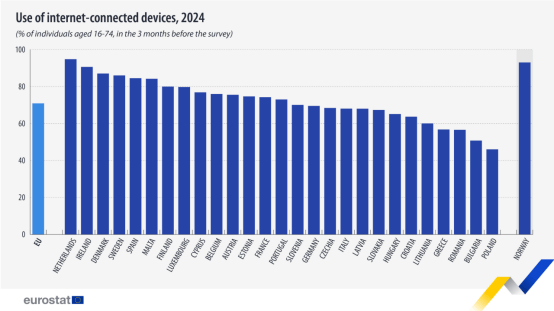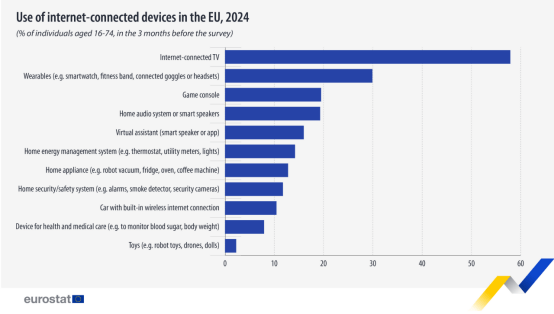The Internet of Things (IoT) has become one of the most transformative forces of the digital era. Yet, paradoxically, as it becomes more widespread, it seems to fade into the background of everyday life. According to the latest survey by Eurostat, over 70.9% of the European population now uses smart IoT devices in daily life. From connected TVs and wearable devices to intelligent appliances and cars, IoT is deeply integrated into modern living — quietly powering a new wave of smart consumption, production, and governance.
Ironically, this growing invisibility does not signal decline. Instead, it reflects IoT’s maturity and indispensability. Just as electricity or the internet itself became invisible infrastructure, IoT is evolving into an essential yet unobtrusive layer that enables intelligence everywhere.
Table of contents
- The Rising Tide of Internet of Things ( IoT) Adoption in Europe
- Barriers to Adoption: Perception, Price, and Privacy
- IoT in China: Quiet Expansion Behind Smart Consumption
- IoT: The Hidden Infrastructure of Smart Consumption
- Why IoT’s “Invisibility” Is a Sign of Maturity
- The “Invisible” Internet of Things ( IoT): Embedded in Everyday Life
- Internet of Things ( IoT ) and the Future of AIoT Synergy
- Conclusion: The Disappearing Technology That Shapes the Future
The Rising Tide of Internet of Things (IoT) Adoption in Europe
Eurostat’s latest findings reveal that IoT penetration in Europe has reached an all-time high, demonstrating the continent’s growing digital maturity. In 2024, more than seven out of ten residents reported using at least one IoT-enabled device at home.
Among all EU member states, the Netherlands leads with 94.8% of households using connected devices, followed by Ireland (90.6%) and Denmark (87%). At the other end of the spectrum, countries such as Poland (46.1%), Bulgaria (50.8%), and Romania (56.6%) still have room for growth, reflecting disparities in income levels, digital infrastructure, and smart home affordability.
When it comes to device preferences, smart TVs dominate the market. Roughly 58% of respondents reported owning or using one, making it the single most popular IoT product in Europe. Wearable devices such as smartwatches and fitness trackers follow, with nearly 30% of residents using them. Around one in five people use connected gaming consoles or smart sound systems, while 16% rely on virtual assistants like smart speakers.
Smart home and automation solutions are gaining momentum as well:
- 14.2% of residents use connected energy management systems.
- 12.8% operate smart home appliances.
- 11.8% have installed IoT-enabled home security systems. Even connected vehicles are becoming part of daily life, with 10.5% of residents owning cars equipped with built-in wireless connectivity.
In short, IoT is no longer a niche innovation — it’s a mainstream digital reality.

Barriers to Adoption: Perception, Price, and Privacy
Despite impressive adoption rates, Eurostat’s survey also identified key barriers among non-users.
- 41% said they simply saw “no need” for IoT devices.
- 9% found them too expensive.
- 7% expressed concerns over data security.
- 6% cited lack of technical knowledge.

These figures reveal an important insight: the challenge for IoT is not technological, but perceptual. Most potential users are not rejecting IoT due to functionality — rather, they fail to perceive its necessity or benefits. This aligns with a broader trend in mature technologies: once they become reliable and ubiquitous, they fade from conscious attention.
IoT in China: Quiet Expansion Behind Smart Consumption
Although there is no unified national survey equivalent to Eurostat’s, data from China’s consumer electronics and IoT industries suggest a similar — and accelerating — trajectory.
According to QuestMobile’s 2025 Mid-Year Digital Ecosystem Report, smart TV usage in China has reached 288 million active devices, an all-time high. Likewise, data from AVC Revo show that China’s air conditioner market sold 196 million units between August 2024 and July 2025 — an 11.5% year-on-year increase, with over 100 million units sold domestically. Notably, smart and connected air conditioners accounted for the largest share of this growth.
Leading Chinese manufacturers are doubling down on Internet of Things (IoT)-driven product strategies.
- In the first half of 2025, Midea’s smart home business contributed 66.6% of total revenue.
- Xiaomi’s large smart appliances segment grew 66.2% year-on-year, with over 5.4 million air conditioners shipped.
This wave of consumer IoT innovation mirrors global trends: as device intelligence rises, users no longer think of products as “connected” — they simply expect them to be.
IoT: The Hidden Infrastructure of Smart Consumption
IoT has quietly become the technical backbone of intelligent consumption. From government strategies to corporate ecosystems, “smart” increasingly means “connected.”
In August 2025, China’s State Council released new policy guidelines for the “Artificial Intelligence Plus” (AI+) initiative. One key section focused on AI-driven smart consumption, calling for the expansion of smart terminals, connected vehicles, intelligent robots, and smart wearables — all of which rely fundamentally on IoT connectivity.
Similarly, the National Development and Reform Commission (NDRC) emphasized that the next phase of digital consumption will evolve from tools to “intelligent partners.” New-generation smart terminals such as connected cars, AI-powered devices, and household robots are no longer passive executors; they sense, decide, and learn through IoT-driven data exchange.
From this perspective, IoT is not merely an accessory technology — it’s the enabling fabric of intelligent interaction. Sensors, networks, and edge devices together create a seamless smart environment, transforming data into decisions and objects into agents.
Why IoT’s “Invisibility” Is a Sign of Maturity
Paradoxically, while IoT’s role is expanding, its visibility in public discourse has declined. Fewer policy papers or media headlines highlight “IoT” explicitly, and its once high-profile presence in tech discussions has faded. However, this is not a symptom of stagnation — it’s a hallmark of maturity.
Three main factors explain this “vanishing act”:
- Specialized Complexity – IoT is not a single technology but a system of interconnected components — sensors, networks, cloud platforms, and analytics — each specialized and technical. The general public experiences outcomes, not mechanisms.
- Shifting Attention Toward AI – The explosive growth of artificial intelligence, large language models, and digital agents has absorbed much of the tech media spotlight. Yet, AI cannot function without IoT’s real-world data inputs. Together, they form AIoT — the convergence of intelligent sensing and intelligent reasoning.
- Transition to Infrastructure – As Gartner’s technology maturity curve predicted years ago, IoT has moved beyond hype into industrial-scale deployment. Its integration across industries — manufacturing, logistics, healthcare, and urban management — means it’s no longer perceived as “new,” but as part of the digital foundation.
In other words, the less we talk about IoT, the more we rely on it.
The “Invisible” Internet of Things (IoT): Embedded in Everyday Life
Mark Weiser, often regarded as the father of ubiquitous computing, once said: “The most profound technologies are those that disappear.” IoT today fits that description perfectly.
From smart locks to connected appliances, wearable health trackers to autonomous vehicles, IoT is quietly everywhere. Most users don’t consciously think about sensors collecting environmental data, wireless modules transmitting signals, or edge gateways processing analytics. They simply experience smoother, safer, and smarter living.
Examples of this “invisible intelligence” are all around us:
- Smart meters and grids have replaced manual readings.
- Connected bikes and logistics platforms enable real-time asset tracking.
- Industrial IoT (IIoT) optimizes production lines in factories.
- Intelligent transportation systems manage congestion in smart cities.
Each case reflects IoT’s transition from front-stage innovation to backstage enabler — invisible, but indispensable.
Internet of Things (IoT) and the Future of AIoT Synergy
The next frontier for IoT lies in its integration with artificial intelligence — the AIoT era. Over the past decade, IoT systems have accumulated vast amounts of sensor data across consumer, industrial, and civic sectors. Now, with advances in AI models and edge computing, that data can be contextualized, predicted, and acted upon in real time.
This convergence has powerful implications:
- Edge-AI systems allow decision-making directly at the data source, reducing latency and improving efficiency.
- Smart manufacturing leverages predictive maintenance and digital twins to cut costs and boost productivity.
- Intelligent urban management integrates traffic, energy, and public safety systems for greater resilience.
In essence, AI gives IoT the ability to think; Internet of Things (IoT) gives AI the ability to perceive. Together, they redefine intelligent connectivity as the cornerstone of digital civilization.
Conclusion: The Disappearing Technology That Shapes the Future
As IoT quietly permeates every layer of the economy and society, its fading visibility should not be mistaken for irrelevance. On the contrary, IoT’s “invisible presence” marks its evolution into the digital world’s essential infrastructure — the hidden nervous system connecting devices, people, and processes.
Whether in Europe’s connected homes or China’s booming smart appliance market, Internet of Things (IoT) has achieved what all great technologies aspire to: ubiquity without attention. It has stopped being a novelty and started being a necessity.
In 2025, the International Telecommunication Union (ITU) echoed Mark Weiser’s timeless insight: “The best technologies are those that disappear into everyday life.” The Internet of Things is doing just that — quietly, steadily, and profoundly reshaping the way we live, work, and interact.
